March 29, 2006-The NE Monsoon Loses its Power.
 Jibboom Bay Jibboom BayIt is springtime and the Central Asian high pressure zone, formed each winter by bone chilling cold of northern Asia, is losing its power. Created by heavy cold air descending over the Mongolian Plateau, the high weakens and then dies when sun moves back north of the equator and again warms the Asian Continent. The Northeast Monsoon, the cold and strong winds born in the high and formed by that cold air sinking over Asia and then flowing out onto the South China Sea, by April no longer threaten sailors voyaging on the coasts of China or around the Philippine Islands. The Northeast Monsoon no longer carries the punch it had during winter. For the crew of the sailing vessel Wings, cruising south through the Philippines towards Borneo, the death of the NE Monsoon is met with mixed emotions. On one hand, we relish the clear skies and calm nights in the quiet anchorages which are common during the transition months of April and May. We have long since tired of the howling nights that were the norm while the monsoon blew. But sailing is not the sure thing it was during the NE Monsoon. The reef lines have been cast off and the heavy weather jib remains stowed. If we want to sail we need the light air sails and patience. Today we started out, as we do most days during this time of transition, motoring. That was OK; we charged the batteries and made some water. By noon we had a bit of wind from the Northwest, some onshore flow into the Western Philippines. It was not predicted by the weather computers in North America or by the weather minions in Tokyo or Taipei, who dispense each day their assessments of the weather situation in the Western Pacific by weatherfax, all of which we religiously monitor, however, we expected it; we saw it yesterday and the day before.  Calm Day Calm DaySo we watched the NW wind slowly build. When it got to 9 knots we took down the sun awning and rigged the sails; full main and 3/4 oz spinnaker, the old one, which is expendable, not any of the racing kites which are stowed securely below deck. At 11 knots of wind we stopped the motor and set sail. It was a bit of a struggle most of the time, hardly enough wind to keep us going, but occasionally we got 13 or 14 knots of wind and then the boat came alive, 7 knots. Otherwise we were barely going better than when we were under motor, but at least we were not using diesel, and the cabin could cool down once the motor was turned off. At the entrance to Port Barton we looked at the clock and decided to carry on. We hardened up and kept sailing. We also bypassed Boyan Island, with its harbors and coves. Still too early and we are sailing, so, lets keep going. At 16:00 we approached Jibboom Bay. One comment in the guide book said, Nothing Special about this bay. But another said it had charm. We turned in as an afternoon thundercloud over the hills to the east shut off the wind. We dropped the sails. Jibboom Bay was quiet and calm, and the hills, with their heavy forests of old growth Philippine Mahogany, gave a fragrance to the air. We slowly motored in and looked for an anchorage, During the transition months, between the NE Monsoon and the coming SW Monsoon, the nights are mostly calm. We felt that we could anchor anywhere. Protection from the wind was not needed, or if it was, we didn't know from which direction we should seek cover, So we found an attractive hillside covered with huge trees and footed by small sandy beaches and a few palm trees, and we set down our anchor in front of it. We poured the last of our gin and sipped it as we watched the sun go down, Tomorrow we will repeat the exercise, only without the gin, its all gone, heading on south. Fred & Judy, S/V Wings, Palawan 10deg 21 N, 119deg 00E ----------
radio email processed by SailMail
for information see: http://www.sailmail.com Labels: crew, Philippines
MARCH 27, 2006- EL NIDO
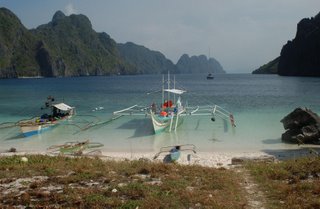 Fjord Country in The Philippines Fjord Country in The PhilippinesWe arrived in El Nido, on Palawan Island, in the Philippines, ten days ago, and have been visiting in nearby Bacuit Bay, where El Nido is located, since then. The sleepy, wild-west, town of El Nido is mostly a backpacker destination, where people who have heard of it, and have endured a bouncing 8 hour jeepney ride up from Puerto Princesca to get here, gather at the end of the road for a real adventure.  El Nido El Nido El Nido El NidoWe are on an adventure ourselves, touring around the bay on our boat looking for interesting spots to anchor. CORONG CORONG BAY AND EL NIDO On the back side of the point where El Nido is located is a bay called Corong Corong Bay. It is scenic and protected, and here you can anchor your boat and catch a tricycle taxi into town for provisions or cold beer, or just sight seeing. There are a few families living at Corong Corong living in thatch houses which extend on stilts over the water. On our way in a man on the beach motions to us to land where he is standing. He introduces himself as Felix, and he asks if we need to have laundry done. We do; (maybe he saw the large bag in our dingy). A woman walks up with a baby in her arms and in articulate English tells us she can do it, by hand, and it is 70 pesos a kilo. She removes a cloth covering a scale on the sand next to the house and we weigh the bag; nine kilos, about $12 for wash dry and fold. We realize this is a well organized routine they go through for any yachties who come ashore. Its OK with us. 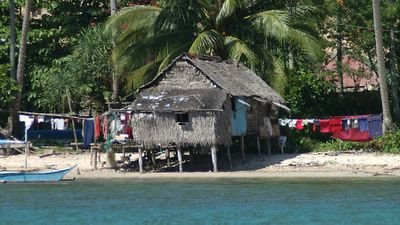 Laundry LaundryWe go into El Nido and find a pleasant little town with a few stores and tourist establishments, mostly guest houses, bars, and simple restaurants on the beach. 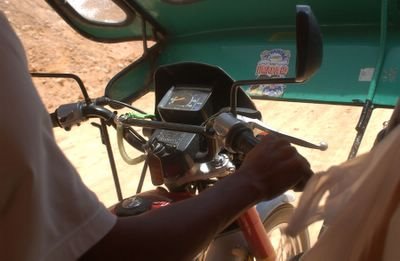 Inside an El Nido Taxi Inside an El Nido TaxiWe buy what we need and try email at one of the two places which have signs about Internet. The power is off in town, and the computers aren't working. That night, the power is still off, but most businesses have generators, and we finally get a shot at the internet. It is slow and we accomplish little. It doesn't matter, the dinner was good. The next day, from the boat, we can see our sheets and towels on the line by the womans house. More El Nido PhotosClick here so see the view od El Nido cliffs out our hatch. Click here to see an El Nido Traffic Jam, (it's all relative, Isn't it?) Click here to see an El Nido shopping trip Click here for Judy's self portrait Click here to see a local shop Click here to see a loaded Jeepney. Would you wish to ride this for eight hours? Click here to see a man and his dog A man stops by in a dingy. It is Benoit, a friend from Hong Kong, and his cat Atmosphere is anchored behind the next point. He tells us that there are much better places around Bacuit Bay that we should try to visit. We decide to go on a tour. We collect our laundry and it is marvelously clean and smells fresh. We load what provisions we can get in El Nido, and we are ready. We like El Nido and Corong Corong Bay, but it is time to look around. We weigh anchor. BACUIT BAY  Split Rock Split RockBacuit Bay covers about 80 square miles and it is dotted with high, shear sided islands. They rise vertically from the sea, and look like sentinels. When you are close to them they stand far over your head. The sea around them is deep and clear. The first days we just motor all over Bacuit Bay looking at the amazing scenery: blue waters, white sand beaches, and tall, tall, rugged islands. It is stunning.
 Judy on The Sand Judy on The Sand
 Banca & Swimmers Banca & Swimmers
More Bacuit Bay photos:
Click here to see a gorgous beach.
Click here see Judy walking on white sand.
Click here for a Bacuit Bay Scene
BOX CANYON AT LAGAN ISLAND  Banca & Swimmers Banca & SwimmersOne of our first stops is Lagan Island. After dinner we go on deck to watch the stars come out. We at Lagan isl;and in the center of what feels like a box canyon, surrounded by high cliffs which leave only a portion of the sky visible in which to watch for stars. Frogs or birds or some other night time creatures fill the air with their sounds, and the cool breeze wafts over us coming down from the hills above. We are anchored in the center of a small cove on, but it feels like somewhere high up in the mountains.. We watch the few stars that we can see, and try to pick out constellations. The cove is still, and the night dark. More Lagan Island photos: Click here to see our achorage at Lagan Island Click here for a sunset shot Click here to see the cliffs at night CATHEDRAL CAVE A couple of cryptic notes in our guide books mention a Cathedral Cave on Pinsail Island, supposedly good for a visit. We are not sure which island is Pinsail Island, the chart is vague on that point, or what Cathedral Cave is, but we decide to try to find out, We set off in the dingy towards a a group of small islands. One must be Pinsail. The likely candidate looks like a giant ice cream cone and when we circle around behind it a opening appears in the limestone wall. The opening is ten feet wide and thirty feet high, and there is deep water going right inside. This must be Cathedral Cave. We motor in. A cave opens up, the ceiling is well over 100 feet above us. Limestone columns line the walls like pillars in a church. Far above our heads is a bit of daylight coming in though a hole somewhere around a corner. The waterway inside ends after a few yards and the floor is large boulders, but the cave goes on. It splits in two and continues out of sight into the darkness. We look in awe at this cave for a few minutes, then we depart and head back toward Wings.  Cathedral Cave Cathedral Cave  Looking Out from Cathedral Cave Looking Out from Cathedral Cave TAPUITAN FJORD  Fishcanp and Bancas Fishcanp and BancasIt is hard to find words that adequately describe the narrow Tapiutan Straits between Maniloc Island and Tapuitan Island. Think of it as a fjord. It is a narrow, twisting, body of deep water between the two high ridge-like islands. The islands are sided by vertical cliffs of dark gray limestone topped everywhere by weathered jagged, razor like points of rock, and crisscrossed by diagonal cracks and crevasses. On top of every peak and in every crack and crevasse are green tropical plants and small bushes. The water is flat, protected from most of the winds by the curves of the strait. The sun beats down on the limestone and foliage and the blue sea sparkles with tiny waves. Light green shallows lie along the edge of shoreline, where the coral grows, and sand under the surface glows with a luminescence. The coral ends abruptly a few yards from shore and the bottom drops suddenly to depths of a hundred feet or more. Spaced unevenly along the foot of the grey walls are small sandy beaches, blindingly white with pure, fine, powdery sand. The beaches are inviting and during the heat of the day we visit a few and swim in the cool water. The fjord is quiet What sounds there are, like a banca engine or the voice of a fisherman, echo across the water, but mostly we hear only the sounds of schools of tiny fish leaping from the water, chased by lean predators. Both prey and predator splash back in unison and then repeat the process half a second later, and then again, through the long hot day in the still fjord. Such is the beauty of this place that we anchor here even though we cannot find any depth less than 90ft. We run out 200 feet of chain and then listen to it rumble across the rocks down there, but in the still fjord there is little wind to make the anchor drag, only gusts and puffs which come down from the hills at night to make us nervous. We take down the awning each night, more to reduce the noise of it flapping than because of the wind strength; and we set it again each morning to give us much needed shade. Snorkeling along a sandy patch on the far shore and we encounter a large school of small silver fish, so many that they look like an opaque silver cloud in the water. We swim among them as they pass us endlessly around a large oval, and bigger fish lurk on the periphery. We see a large barracuda motionless nearby; then it slowly moves off. A ray flaps by. We stay in Tapuitan Fjord for four days. THREE CAMPS OF FISHERMEN. There are three camps of Filipinos staying near us in the fjord. One group lives in a collection of houses on a 100 ft section of sandy beach under a massive wall of limestone which overhangs them 1000 feet up. There are a handful of Bancas pulled up on the sand. This camp has families and looks more or less permanent, with women and babies among the shelters, and men working on the boats and nets. At night there are lights here and we can sometimes hear the sound of a radio news broadcast. We visit in the dingy and the people smile at us as we approach but they are shy and no one invites us to land. We can see that their shelters are small in scale, mere bamboo framed sleeping platforms with roofs and walls of woven palm leaves, but they look cozy and are fastidiously clean. Another camp is on a point of the island near us. An old concrete house stands there, occupied by someone else and the band of fishermen are staying in the open on the beach nearby, sleeping exposed, and hanging wet clothes on the rocks to dry. They have several small bancas, without engines, and one bigger banca with a motor, and they pile into that one every few days and go away for several hours. The men paddle out in the small ones every morning at dawn, returning before the heat of the day, and go out again in the evening. We don�t know if they catch anything. During the mid day heat they huddle under the the awning of their large banca, tied to shore. We land our dingy at this beach and walk around. The men of this camp look sunburned, dirty, and ill kept. There are no women here. We see large fishing lures shaped like octopi and spot a few dried octopi stretched on a piece of netting; that must be what they are after. The third camp consists of three men living in a cave behind the tiniest patch of sand, and they have one small banca. We wonder what endeavor keeps them here. We see them motor up to the shear rock wall and two men disembark from the banca and disappear among the limestone crevasses. The third then cruises around the fjord all day dragging a fishing lure. Where have the two others gone; we can't see them? What are they doing? Then, late in the day, when the sun has already gone behind the ridge, we see one man climbing down the cliff. His bright yellow shorts make him visible against the dark limestone. Judy puts the binoculars on him and expresses amazement that he is coming down the rock wall, among the razor limestone points, with a small pack on his back, in shorts, tee-shirt, and flip flops,Click to see the Man in Yellow Shorts. She watches him stop, precariously balanced on a ledge, and he takes off an apparently damaged flipflop and attempts to put it back together, then proceeds again. He stops every dozen or so yards to repair his shredded flipflop. I realize that the two men have gone up the cliff searching for bird nests, coveted in other parts of Asia for birdnest soup. The bird's nests might bring a nice price, but apparently not enough to buy climbing shoes. When the man in yellow shorts reaches the water's edge he whistles and the banca driver comes back to retrieve him. I wonder where the third one is? Later, just as night falls, he appears at the bottom of the cliff in another spot, and he too is retrieved. Motoring back to the campsite the three inspect each other's catch and the man in the yellow shorts studies the bottom of his feet. The next day they are gone, their cave empty. More Tapuitan Strait Photos Click here and here and here and here and here to see more of Tapuitan Strait GUNTAO ISLANDS This is our last stop on the El Nido cruise. The Guntao Islands are a bit more wild, and a bit more remote then the rest of the islands in Bacuit Bay. They are far out to the west, exposed to the South China Sea. We tuck into a bay in the west side, protected from the east winds, where there is a sandy patch for our anchor The wind and waves pass around us, leaving us a small bit of quiet water. We anchor here and wonder if the peace will last. We go to the beach but a low swell which comes into the bay, one which we didn't notice from the boat, and turns the shoreline into a surfing beach. We try to go ashore anyhow but the dingy wheels get stuck in the soft sand on the steep beach. We struggle to pull the boat up. Then we find the sand so soft it is difficult to walk; so much for the exercise. We go back to Wings, tie off the dingy, and swim ashore to do some snorkeling. The water is clear and there are quite a number of fish, some big ones. Later I scrape barnacles off the propeller and keel of Wings. I don't know when or if I'll get a chance to do it again. Before dinner we watch the sun set in the west, the first sunset we've seen in an anchorage since Borocay in Febuary. We've been inside island groups with no view of the ocean to the west. Here, the view is clear, the horizon is unobstructed. Tomorrow we set sail for South Palawan, to check out of the Philippines. We figure it is five days of short hops down the coast. We hope for wind. Fred & Judy, SV Wings, Palawan ----------
radio email processed by SailMail
for information see: http://www.sailmail.com Labels: Philippines
March 17, 2006-I went Sailing on my 60th
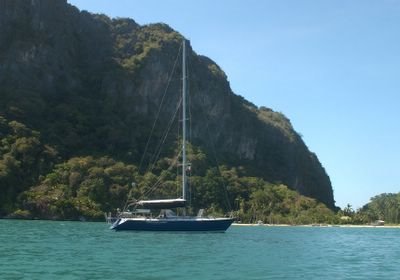 Anchored after a good Day's Sail Anchored after a good Day's SailIt is Saint Patrick's Day. I turned 60 today. We went sailing. Tonight we enjoy a calm anchorage in Corong Corong Bay, near El Nido, in Palawan,
after sailing from Maricaban Bay on Busuanga. Since it is my birthday, and we've just had a great sail, we are celebrating. First we have a few Welcome to Corong Corong Bay drinks on board, then Judy says to call Su Ying and get the lowdown on getting to town from here, but I say I dont want to call Su. The only woman I want lean on is her. Judy starts to sing Lean On Me. I look up that song in my music catalog and find I have a copy of the Bill Withers track, Lean On Me. I play it. Judy dances around the cabin. That's what two beers and two gins after a great sail will do. We were sailing out of Maricaban Bay (or El Rio Y Mar Resort) yesterday at 13:30. We slip the mooring, motor upwind to clear the reef, then hoist the main. When we have room to bear off onto a close hauled course the jib goes up and we sheet in the sails. Wings heels to the breeze and we kill the engine. The American flag is flying on the backstay and we sail past the resort, and we know we are looking good. The phone rings and it is Tequilla Mike, telling us so. One tack and we clear the bay, and head west, for Palawan. Goodbye Maricaban, nice stay, wonderful people. We have elected to skip the islands between Maricaban and El Nido, choosing to sail the whole way in one hop. During the night we sail offshore, off the shelf and off soundings. It makes the sailing more relaxing when we know the bottom is down 1000 meters, instead of just 18 or 12. Tequilla Mike said the wind would go light after Pinnacle Rock, and it does. We drop the sails and motor slowly, on the autopilot, charging batteries and running the watermaker. At 02:30 a light Easterly fills back in and we turn off the motor and set sail again. It is an easy beam reach in 10 knots of wind. By 08:00 we have 15 knots and at 10:00, as we approach El Nido on Palawan Island, it is gusting 30. Now we have our hands full. We still have a full main and the #4 jib and, with a wind shift, we are now on a close reach. Judy pulls on the main outhaul, flattening the bottom of the sail. We ease the vang, allowing the top to twist off. Still, with these powerful gusts we are hitting mid eights. I have disconnected the windvane and I am hand steering. When a puff comes I pull on the tiller, the boat heels sharply, the deep blades of the keel and rudder bite, and they turn the wind in the sails into pure speed. We accelerate. It is wonderfully exciting sailing, going this fast in this flat water, and we sit on the high side, watching the water speed past, far below us, but heading for an unknown anchorage with poor charts takes some of the gloss off the sailing. We are slightly nervous; on high alert. The harbor of El Nido is an unprotected lee shore in this wind and we are storming into it. There is supposed to be an exit past an island to the west, but we don't see it. What we see is spectacular scenery with high cliffs and lush jungle foliage, all under heavy grey skies and there is dark water and white caps all around us, and a dead end. Then the gap opens up to our right and we turn and sweep through at 8.5kts; kids on the shore whoop and holler at us. We peel around Ipil point and here the chart plotter is useless; our position is uncertain and the charts have little detail; we have to eyeball our approach to Corong Corong Bay. We drop the jib and sail slowly upwind with just the main. Twice we have bail out and spin around, reversing our course as the depth sounder unwinds with an alarming suddenness that betrays a reef under our keel. Finally we find our way in and drop the hook in 30 feet, sand, and it bites immediately. We are here and it is a gorgeous place. We are surrounded by tall limestone islands, lush vegetation, and blue seas. The anchorage is excellent. We'll send photos as soon as we can, but right now, there is another cocktail waiting. Fred & Judy, SV Wings, El Nido Corong Corong Bay is just south of El Nido, Palawan province, The Philippines.
It is located at 11deg 10.7 N, 119deg 23.2E ----------
radio email processed by SailMail
for information see: http://www.sailmail.com Labels: Philippines, sailing
March 15, 2006-Maricaban Bay
 Beach Vollyball Victors Beach Vollyball VictorsWe really like beach vollyball, and we had some great fun at the net at the El Rio Y Mar Resort in Maricaban Bay. Lots of other cruisers told us to stop at Maricaban Bay and meet Tequila Mike. They said the resort is really "cruiser friendly". We found that it was true. Mike is interesting and a knowlegable sailor himself, and his resort (he is one of the owners) is a great place for cuisers to stop. We loved our stay. 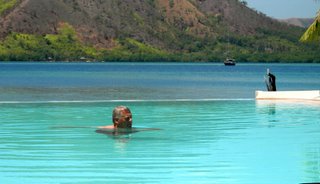 Pool at Maricaban Pool at MaricabanOf course the pool is terrific, and we met some other interesting people amopng the guests, including several Clipper Challenge sailors on holiday while their boats were being fixed.  Swapping Sea Stories Swapping Sea StoriesWe had fun swapping sea stories with them around the pool. Add in cold beer, good food, and a healthy discount for cruisers (can you believe that?) and Maricaban was great. 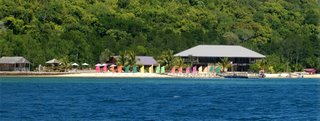 El Rio Y Mar El Rio Y MarNow here is the icing on the cake. We'd been getting short of cash, since there are no ATM's on Busuanga Island. We had some pesos, maybe enough to get to El Nido, but we wished we could buy some diesel and get some other provisions too. Well, at El Rio Y Mar they opened up their storeroom (a small warehouse, actually) and sold us anything we wanted to buy, plus diesel, and put it all on our credit card. We were astonished, and it made this whole portion of the cruise a lot more relaxed for us. we love this place. Fred & Judy, SV Wings, Busuanga Labels: Philippines
March 12, 2006-Calauit Animal Reserve
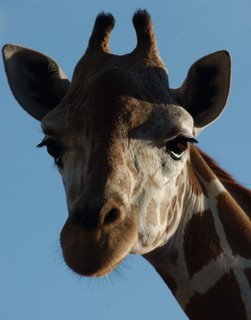 Hello? Hello?Ferdinand Marcos thought it would be cool to have some African animals in the Philippines, so, with the help of a cruiser, (so we hear) he imported a bunch and put them on a big reserve on Busuanga Island. The reserve is still there though Marcos is long gone. Some of the animals remain too, and cruisers often stop in Illutuk Bay to visit this reserve. 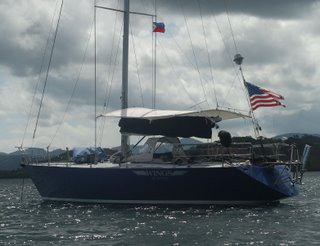 Wings at Illutuk Bay Wings at Illutuk BayWe anchored in Illutuk Bay, after narrowly missing some rather nasty reefy spots, and went ashore. There an attendent help us arrange a tour for the next morning. At 7:00 we piled into a well worn jeep and were driven around few hours, with a running commentary by the manager of the place. It was great to be able to get close to these animals, and feeding the girrafe by hand was thrilling. Click here for more photosThere are pressures on the Calauit Animal Reserve. Many local people were evicted from the reserve when it was formed (but compensated, we're told) and now the money they received is gone, and land being in short supply, they want to come back. Some have simply squatted. With courts in the Philippines being as they are, the court cases to evict these people can go either way. And click here for even moreThe other problem is that politics being as they are in the Philippines, no polician now wishes to give any credit to Marcos, and they are loathe to support Marcos' Animal Reserve, (This is probably a significant factor behind the recent court decisions in favor of former land owners.) In fact I suspect, although no one would confirm it, many of the animals have been sold off. A brouchure dated 2004 list several species and much higher animal counts than we saw. Where did they go? Fred & Judy, SV Wings, Busuanga Labels: Philippines
March 9, 2006-Westward through Palawan Province
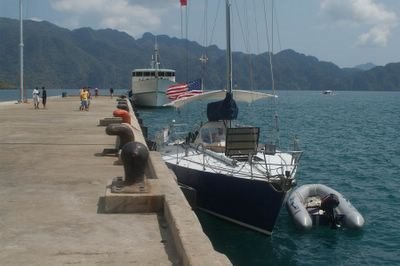 Coron City Pier Coron City PierWe weigh anchor at Coron on Thursday and with the awning up and sails stowed, motor slowly to the west through the islands and channels of the Calamian Islands, in Northern Palawan Province. The sky is clear and the wind is light and we lie around on deck in the shade of the awning using the autopilot to steer, watching the chart plotter as we pass islands and around reefs. The visibility is good and it is easy to navigate and we are relaxed, enjoying the peace of the day. We could be sailing but that would mean taking down the awning and getting the sails up and then there would be the stress of sailing in close quarters with the reefs, plus we would be very hot in this direct sun. We make no moves to set sail. This is easier. Anyhow, we need to run the motor to charge the batteries and make water. So we have our excuses.  Calamian Islands & Seaplane Anchorage Calamian Islands & Seaplane AnchorageIt is dryer here in this part of the Philippines. There is more brown and less green on the islands than farther to the east. We are amazed at the diversity of islands. Coron Island is shear and jagged, with naked black limestone cliffs and ridges like serrated knife edges. Next to it lies Busuanga Island, with rolling brown hills and savanna like grass. Busuanga has cattle ranches in its interior, including one of the largest in Asia, we were told, and a game reserve with African animals. When we drove across Busuanga to the airstrip on a plain in the middle of the rolling hills we thought it looked like Africa and we could imagine we were somewhere in the middle of that dark continent; maybe Kenya. We pass Tangat Island, a high volcanic looking cone with sandy beaches in small coves around its base, and nearby there are low islands barely above the level of the sea. We enjoy the scenery. Off Tangat Island the breeze freshens a little and a wind chop appears. With the deep blue water and blue sky and the majesty of Tangat Island in the background it is very attractive, and I can visualize sailing here, our boat and its white sails tiny on the blue sea against the tall backdrop of the green mountain. I remember sailing in Canada in places which looked like this, and the images from those days have stayed vivid in my mind for all these years. I look wistfully at the scene. Then the wind switches around and quickly dies. The temptation to sail is gone. In the afternoon we anchor in Port Culion, a deep indentation just east of the town. Culion is a small, historic, Philippine town built around a hill next to the sea, with many old buildings, including a hospital which housed the large leper colony for which Culion was famous for many years, and a fort. We launch the dingy and motor to the town dock. The security guard allows us to tie our dingy in a small basin next to the passenger terminal. A sign says Welcome to the Culcag Marina. We walk around town and buy some tomatoes and radishes in the market. We hire a tricycle to take us to the old fort and leper sanatorium, and we walk past the church where a service is being conducted. Later, back down along the waterfront, we find a bar called The Safari and we go in for a beer, but it is not very cold. We return to the boat and cook a chicken we bought, and we discuss our plans for the next few days. A tropical depression has been on the weather charts since last week, and when it first appeared, off to the east of the Philippines, it was forecast to develop into a typhoon. For a few days we were thinking about preparations we would make for a typhoon. Then it was downgraded to a simple low pressure zone and the current forecast is for it to pass to the south of us and affect us very little, except maybe a couple of days of rain.
We are anxious to get going in the morning and move into another set of islands where we can sit out any rain or wind from the low, but I know that if the sky is cloudy the light will be bad for seeing reefs and we may have to stay here in Port Culion. We decide that it will be OK, this harbor is well protected. In the morning a north wind blows into the harbor, a good sailing breeze. The sky is grey but I decide we can still see the reefs. We prepare to set sail. I put the jib on deck and lead the sheets. Judy takes off the mainsail cover. We weigh anchor and motor out of the harbor and then we hoist the sails. It is a beat out of Culion in 15 knots of wind and we are close hauled and pointing high. We have to clear one reef and an island, Chindonan Island, before we can bear off to the west. We take turns on the winches, the other steering. Tacks go silently; we have done this before. Tack on tack we work to weather, it is WINGS best point of sail. The reef we must avoid is directly upwind of us. We consider tacking to leeward of it or going on until we can clear it to weather. If we go to leeward then we will be very close to the end of Chindonan Island. If we go to weather of it, we will have plenty of room on the island but we will have traveled extra distance. We tack to leeward of the reef and watch the rocks and green water pass close by our starboard side. We are on a good course to weather the island too, but the wind starts to back, knocking us towards the point of the island. The wind also picks up, to 18 knots. Judy is steering and she points us higher. I trim the sails and put on some backstay. We are just clearing Chindonan Island when I spot a piece of bamboo sticking up from what must be a shallow spot just ahead of us. Tack, I say and Judy says, We are not ready! Tack now! Just turn the boat! I yell. She obeys and puts the helm down. WINGS comes about and I hustle to hand the sheets as fast as she turns. Then she sees the marker, and she says, Good call, Fred. When we can pass the island we tack back and soon we are around it. We bear off. Our speed comes up as we reach to the West. We put on the autopilot and surge down the wide channel under overcast skies past the islands which looked so beautiful the day before. Now their colors are muted in the grey light. The speedometer shows 7.5. Two small bancas with white triangular sails pass silently across our stern. They look tiny. 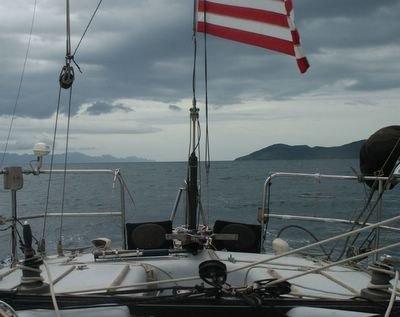 Sailing To Gutob Sailing To Gutob Fred on Deck Fred on DeckThe Calamian Islands look good on the charts but reality is different. Our plan of stopping in them is thwarted. There are aqua culture projects which block almost all of the bays and harbors. We think that they are pearl farms, but whatever they are, they prevent us from entering any of the potential refuges we had picked out from the chart. Then when we can get into some places, we find that the water is too deep. Eighty six feet of water right up to the reef makes for difficult anchoring. We continue to the west. In the afternoon the wind has died and we motor along. We have put the pearl farms behind us and we are near the west end of the Calamian Islands. We proceed up into Gutob Bay where we find the water is shallow enough to easily anchor and no aqua culture. We pass a resort on one island and a town on another. We anchor in a cove which affords protection from all sides, off of a small boat house on shore.  Gutob Bay Gutob BayThe rain comes just after we get the hook down; a thick grey cloud of rain blocks the horizon and moves toward us. When it comes the soft rain washes off the boat. Dust on our decks which has been there since Semirara Island is rinsed away. We set up the water collection system and hope it rains long enough to fill the tanks. The rain also cools us. It is good. We can hear a cow mooing from the island. We eat our meal and drink our wine on deck as night falls. We are happy. Fred & Judy, SV Wings, Gutob Bay, the Philippines Lat 12deg 10.02 North, Lon 119deg 51.667 East. Click these links for more photos of Culion Town ChurchSchool GirlsSafari BarCulion HospitalStilt Houses----------
radio email processed by SailMail
for information see: http://www.sailmail.com Labels: Philippines, sailing
March 7, 2006-The Seaplane Shortcut
 Seaplane SeaplaneWe're at Coron, in Palawan province, in the Philippines, anchored out of town a bit behind an island and tucked up close to it to keep out of the chop which the east wind kicks up around here. We take the dingy to town when we need to go to the market, but the distance makes the trip a little tedious, particularly when the wind is up. Going around the island in the face of a good chop is sure to get you wet. 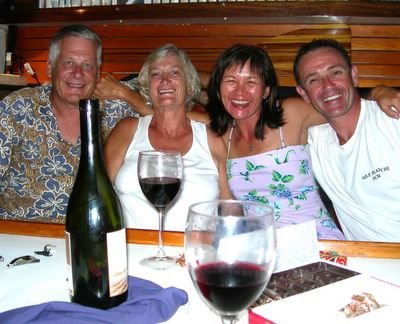 Su Ying & Dave Short Su Ying & Dave ShortSu Ying told us however, about a shortcut through the mangroves behind the island which cuts off about a third of the trip, mostly the choppy part. I call it the seaplane shortcut, after a derelict old seaplane which is half sunk in the mangroves near where the short cut starts; but you can't always get through due to low water when the tide is out. The Seaplane makes a good tidal gauge. Su told me, "Watch the float on the right wing. If it is visible the tide is too low, but if it is underwater then the tide is high enough to take the shortcut". 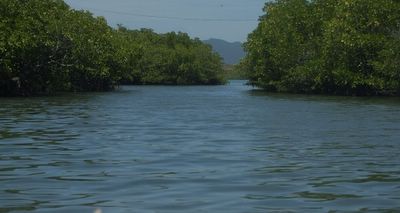 Shortcut ShortcutOnce when we went through some men had a pipe floating on the water across the shortcut; they were filling the water tanks on the island for the resort. We had to wait until they filled the pipe and it sunk to the bottom of the channel. Fred & Judy, SV Wings, Coron, The Philippines ----------
radio email processed by SailMail
for information see: http://www.sailmail.com Labels: Philippines
NEXT Page (More)
, or... GO BACK to Previous Page
|
 Jibboom Bay
Jibboom Bay Calm Day
Calm Day
 Fjord Country in The Philippines
Fjord Country in The Philippines El Nido
El Nido El Nido
El Nido Laundry
Laundry Inside an El Nido Taxi
Inside an El Nido Taxi Split Rock
Split Rock Judy on The Sand
Judy on The Sand Banca & Swimmers
Banca & Swimmers Banca & Swimmers
Banca & Swimmers Cathedral Cave
Cathedral Cave Looking Out from Cathedral Cave
Looking Out from Cathedral Cave Fishcanp and Bancas
Fishcanp and Bancas Anchored after a good Day's Sail
Anchored after a good Day's Sail Beach Vollyball Victors
Beach Vollyball Victors Pool at Maricaban
Pool at Maricaban Swapping Sea Stories
Swapping Sea Stories El Rio Y Mar
El Rio Y Mar Hello?
Hello? Wings at Illutuk Bay
Wings at Illutuk Bay Coron City Pier
Coron City Pier Calamian Islands & Seaplane Anchorage
Calamian Islands & Seaplane Anchorage Sailing To Gutob
Sailing To Gutob Fred on Deck
Fred on Deck Gutob Bay
Gutob Bay Seaplane
Seaplane Su Ying & Dave Short
Su Ying & Dave Short Shortcut
Shortcut.jpg)
